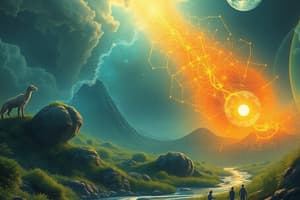Podcast
Questions and Answers
Which of the following factors can decrease Gross Primary Productivity (GPP)?
Which of the following factors can decrease Gross Primary Productivity (GPP)?
- Lower temperatures
- Deficient soil nutrients (correct)
- Increased sunlight
- High humidity
Biodiversity refers only to the variety of animal species on Earth.
Biodiversity refers only to the variety of animal species on Earth.
False (B)
Name one ecosystem that has very high productivity and explain why.
Name one ecosystem that has very high productivity and explain why.
Tropical rainforest; due to high temperatures and abundant sunlight, leading to optimal conditions for plant growth.
Only about _____ of the energy contained in one trophic level is incorporated into the bodies of the next trophic level.
Only about _____ of the energy contained in one trophic level is incorporated into the bodies of the next trophic level.
Match the type of ecological pyramid with its description:
Match the type of ecological pyramid with its description:
Which of the following is true about a food web?
Which of the following is true about a food web?
All producers are autotrophs that can create their own food through photosynthesis.
All producers are autotrophs that can create their own food through photosynthesis.
What role do decomposers play in the food web?
What role do decomposers play in the food web?
First-order consumers are also known as __________.
First-order consumers are also known as __________.
Match the following trophic levels with their corresponding organisms:
Match the following trophic levels with their corresponding organisms:
What is the primary source of energy for consumers in a food chain?
What is the primary source of energy for consumers in a food chain?
Energy is conserved as it moves up through the food chain.
Energy is conserved as it moves up through the food chain.
What is the process by which plants convert light energy into chemical energy?
What is the process by which plants convert light energy into chemical energy?
Which of the following best describes the term 'detritus'?
Which of the following best describes the term 'detritus'?
Decomposers do not play a significant role in nutrient cycling in ecosystems.
Decomposers do not play a significant role in nutrient cycling in ecosystems.
What role do scavengers play in the detritus food web?
What role do scavengers play in the detritus food web?
The rate of solar energy captured in sugar molecules during photosynthesis is known as _____.
The rate of solar energy captured in sugar molecules during photosynthesis is known as _____.
Match the following terms with their appropriate definitions:
Match the following terms with their appropriate definitions:
What happens to the energy released by decomposers in ecosystems?
What happens to the energy released by decomposers in ecosystems?
Higher ecosystem productivity results in fewer producers.
Higher ecosystem productivity results in fewer producers.
List two examples of chemical decomposers.
List two examples of chemical decomposers.
Flashcards are hidden until you start studying
Study Notes
Energy Flow in Ecosystems
- Energy flow is characterized by food chains and complex food webs that link various organisms.
- Food chains depict nutritional sequences, while food webs represent interconnected chains within an ecosystem.
Trophic Levels and Energy Transfer
- Energy passes through trophic levels:
- Autotrophs (producers) create organic material from inorganic substances.
- Heterotrophs consume organic material for energy, categorized into herbivores (first-order), carnivores (second-order or higher), and omnivores.
- Energy transferred through the food chain is dissipated at higher levels, with only about 10% typically moving to the next trophic stage.
Producers
- Primary producers include plants and photosynthetic microorganisms that convert sunlight into chemical energy.
- Chemosynthesis allows some bacteria to harness energy from inorganic molecules for organic matter production.
- Terrestrial ecosystems rely heavily on green plants, while aquatic ecosystems feature diverse microscopic producers.
Consumers
- Consumers vary greatly in size from plankton to large mammals, with roles defined by their feeding practices.
- Scavengers and detritus feeders, such as earthworms and vultures, play crucial roles in decomposing organic matter.
Decomposers
- Decomposers break down dead organic matter, recycling nutrients back into the soil, thereby maintaining ecosystem health.
- Release energy as heat and help in nutrient recovery for plant absorption.
Ecosystem Productivity
- Productivity denotes the efficiency of producers in converting solar energy to biomass, measured as Gross Primary Productivity (GPP) and Net Primary Productivity (NPP).
- GPP is the total solar energy captured, while NPP represents energy available for consumers after accounting for producer's own energy uses.
Biodiversity and Ecosystem Health
- Higher productivity often correlates with greater biodiversity which includes a wide variety of life forms.
- Biodiversity is ecologically and economically significant, offering resources such as food, shelter, and medicine.
Ecological Pyramids
- Ecological pyramids visually represent the distribution of energy, biomass, or organism numbers at each trophic level.
- Types of pyramids include the pyramid of energy, biomass, and numbers, illustrating energy flow and resource availability in ecosystems.
Studying That Suits You
Use AI to generate personalized quizzes and flashcards to suit your learning preferences.




